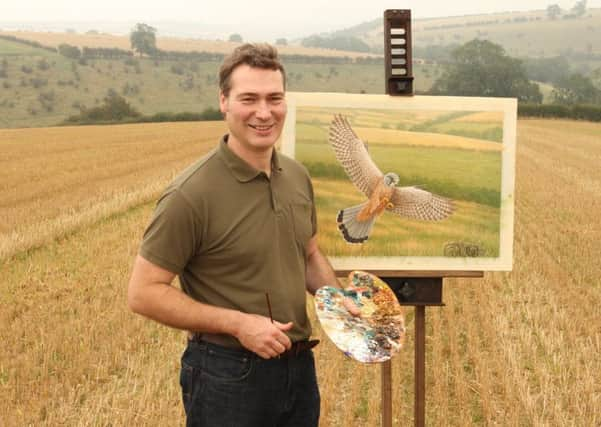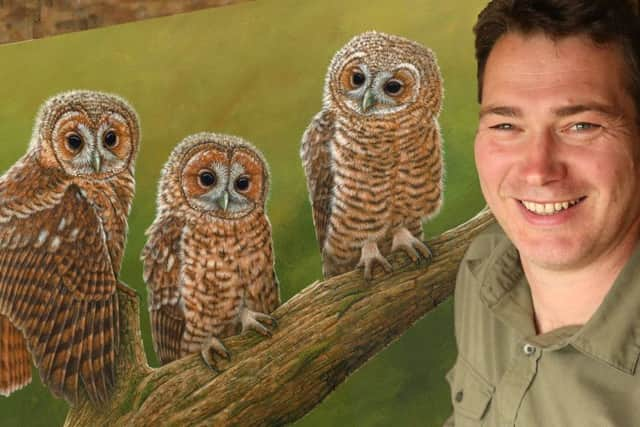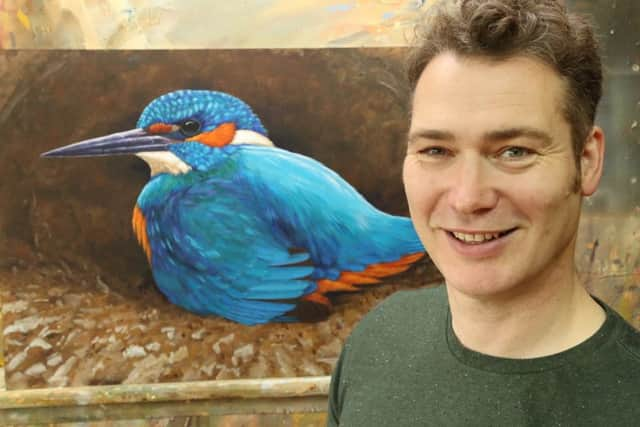Yorkshire’s Favourite Artists: Why globe-trotting wildlife artist Robert E Fuller takes most inspiration from his home county


Robert E Fuller is nothing if not committed when it comes to observing and recording wildlife in their natural habitat; he once spent weeks turning a shed into an artificial kingfisher bank with a hidden observation space for him and his camera.
“One of the highlights of my career was watching the chicks being raised from so close that I could have literally reached out and touched the nest box,” Fuller, the latest person to feature in this newspaper’s Yorkshire’s Favourite Artist series, recalls.
Advertisement
Hide AdAdvertisement
Hide AdAnd when The Yorkshire Post calls his gallery on the outskirts of Thixendale to speak to him for this interview, his assistant gently warns he may have to cut the conversation short as he is looking out for a rare white stoat that he hopes will become the subject of one of his next artworks. However, the stoat only makes a fleeting appearance – allowing time for Fuller to discuss how he has managed to turn his twin childhood loves of nature and art into a highly-successful career that sees thousands of visitors, some from as far afield as the US and Canada, flock to his gallery each year.


Fuller has travelled every continent to watch, photograph and paint animals and birds – from lions in Kenya to penguins in the Antarctic. But he frequently finds most inspiration on his doorstep, spending months in the field observing the character of animals and birds, as well as setting up a network of surveillance cameras to capture the activities of everything from barn owls, kestrels and weasels at their nesting sites.
And the wildlife expert has become a regular contributor to programmes such as BBC Springwatch, The One Show and Countryfile, while also writing a weekly column for The Yorkshire Post.
His successes are all the more laudable having been achieved in spite of severe dyslexia which left him struggling to read and write beyond a primary school level into his mid-30s. Fuller says he was finally prompted into action when he became an uncle.
Advertisement
Hide AdAdvertisement
Hide Ad“My brother’s kids asked me to read a bedtime story, the letters were really big and I just froze. I had to go and get my wife to read it and I just thought, this is ridiculous. I had never been able to read aloud, partly as a result of my dyslexia and partly because I lost my confidence at school.”


He says he became even more determined to improve this literacy when his daughter was born.
“As my daughter grew up, I started reading really simple books to her aloud. I could read it to my daughter fine but if my wife came in I would start stumbling, which is apparently quite common.”
As knowledge of his artwork grew, he was offered newspaper columns, including with The Yorkshire Post, and his wife and assistant would help him to get the grammar and syntax right.
Advertisement
Hide AdAdvertisement
Hide AdFuller was brought up in Great Givendale in the Yorkshire Wolds, where his father Richard was an award-winning farm manager with a pioneering conservationist approach to agriculture.
“I was brought up on a large farm and nature was part of my everyday life, I loved it,” Fuller says. “When I was a toddler, I would look into the garden pond with my nose almost touching the water. Everything you would see in there was almost like science-fiction – tadpoles being eaten by larvae with pincers. They were mini-dramas in the natural world that most people wouldn’t get to see.”
Fuller says he struggled with school but discovered a passion for art and particularly drawing animals. By the time he was 14, was allowed to take extra lessons. He went on to take a BTEC national diploma course in art and design in York but says he was frustrated to be steered away from his passion of wildlife painting after being told the topic was “old-fashioned and boring”.
But he then went on to study wildlife illustration in Wales – and managed to make his start towards a professional career after selling around £1,500 worth of paintings to staff at Chester Zoo where he had worked as a summer job, sketching the animals in his spare time.
Advertisement
Hide AdAdvertisement
Hide Ad“That pretty much paid for my first car and I just set up straight away as an artist,” Fuller explains. “I just thought if you are going to do it, you have to get on with it. I came straight back to Yorkshire and set up in business. I was doing wildlife work and painting people’s horses, dogs, sheep and cows. I did all sorts of different artwork but now just do wildlife.”
In 1998, Fuller and his wife Victoria moved to Fotherdale Farm on the outskirts of Thixendale, where he set up a gallery and studio and was able to observe the wildlife in the surrounding fields. His bi-annual exhibitions quickly became such a success that in 2001, the couple applied for a rural enterprise grant to convert disused farm buildings nearby into a permanent 60ft gallery, with adjoining workshops.
The gallery now gets well over 7,000 visitors a year, with people travelling from all over the world. “I find it quite astonishing that people come from all over the country and all over the world. People come across from Europe on the ferry to Hull and go back again on the same day. It is quite a compliment and you get people who stay over especially. We have regular visitors from Canada and Florida.”
Fuller says he always has several projects on the go, some which never progress beyond sketches and others that take years to complete. “I’m just finishing a painting I started back in 2003, which gives you a sense of the time some will take. That is a very long-term one but I went to Scotland in the autumn and have done three pictures from that trip already.”
Advertisement
Hide AdAdvertisement
Hide AdWith each artwork, he tries to capture the character of each animal or bird. “They are all individuals. I try to study individual animals and birds – I have followed a kestrel in the garden for 12 years throughout his life. I need to make sure it is absolutely perfect. For example, badgers all look different from each other. I’m trying to capture that in a way that gets people excited. Fieldwork is probably my favourite part of the job. Completing a painting in the studio gives you a real sense of satisfaction but I just love being outside with the wildlife and nature.”
But while Fuller is in his element in the outdoors, he says he sees an increasing disconnect between people and the natural world in this country. “Wildlife is having a very difficult time at the moment for various reasons. When I go out, even when I am walking on the streets of York, I hear red wings flying, if there are pigeons scattering, there might be a peregrine you can see overhead. But other people won’t pick up on the same signals.
“I’m always questioning the noises I hear. My ears are listening and my eyes are looking. I think learning more about wildlife and nature should be on the school curriculum. There is so much more that can be done. There are so many different angles – eight times table is a reminder of spiders’ legs, six times table is insects to make it more fun. I hated school and you could make it so much more fun.”
He says he is privileged to do the work he does – but has little time to think too much about it.
Advertisement
Hide AdAdvertisement
Hide Ad“I have been to Africa 13 times and seen a lot of incredible things – cheetahs, lions, giraffes. I used to watch David Attenborough documentaries and think, ‘wow, look at that’ and now I see them and think I have already been there and seen that.
“I’m usually a bit too busy to reflect, it is a full-on job and career and I am often working until midnight.
“It is so busy because there are so many different parts to it, it is like having three full-time jobs at once.”
See Robert’s work at Fotherdale Farm, Thixendale, North Yorkshire, open weekdays 9.30am-4.30pm and weekends 10.30am-4.30pm (tel. 01759 36835). Visit www.robertefuller.com.